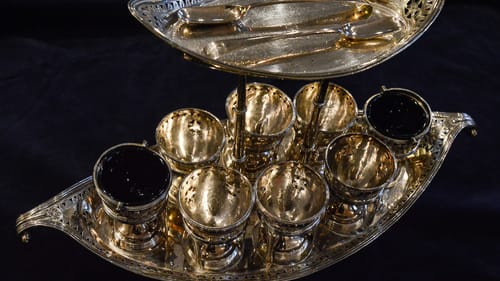Stay in the Loop
BSR publishes on a weekly schedule, with an email newsletter every Wednesday and Thursday morning. There’s no paywall, and subscribing is always free.
Putting hearts and heads together
The Rosenbach Museum presents 'Of Two Minds: Creative Couples in Art and History'

The Rosenbach Museum and Library’s Of Two Minds: Creative Couples in Art and History presents a refreshing counterpoint to the stereotype of the solitary artist, estranged from society, friendless and unloved. The exhibition explores the synergy of artists who found not just love but inspiration in their beloveds.
Drawing on the Rosenbach's collection, the show mines material across time and vocation. Though examples include royalty, theater, and exploration, writers, illustrators, and printers dominate.
Among these are William Blake (1757-1827) and wife Catherine Boucher Blake (1762-1831), May McNeer (1902-1994) and husband Lynd Ward (1905-1985), and Kay Healy (1983- ) and husband Greg Pizzoli (1983- ). The beautifully preserved and displayed papers, prints, and objects are meaningful on their own, but the relationships make them memorable.
Providing creative, managerial, and financial support
Poet and artist William Blake taught Catherine to read, write, and use the printing press. She assisted in coloring printed impressions, a contribution diminished by critics who judged her work “less subtle” than her husband’s, despite it being impossible to know which partner executed specific images.
What is known, though, is that Catherine Blake handled the finances and, after Blake’s death, continued to promote and sell his work. On view is “Visions of the Daughters of Albion” (1793), a poem likening gender-based oppression to slavery. Blake was author, illustrator, and printer, rendering the text in rounded script so tiny that, on its final page, only “The End” is legible.
Louisa Lane Drew and Hester Bateman also brought entrepreneurial acumen to their marriages. Louisa (1820-1897) and John Drew (1827-1862) were both accomplished actors before marrying. Settling in Philadelphia, they appeared at the Walnut Street and Arch Street Theaters before John was asked to manage the latter.

He proved a better thespian than manager, and shareholders shifted his responsibilities to Louisa, making her the first female manager of a major American theater. A case at the Rosenbach contains scrapbooks she kept of playbills with the heading, “Mrs. Jno. Drew’s Arch Street Theatre.” The enterprise thrived during her tenure with offerings that included the Irish play Crohoore-na-Bilhoge (The Foster Brother) in 1862, featuring both Drews in the cast.
John Bateman (d. 1760) was a journeyman goldsmith when he married Hester (1708-1794), with whom he had six children and operated a silver shop. Upon his death, the tools were bequeathed to Hester and she trained her children in the craft; she signed pieces with her mark, HB.
Bateman remained an important name in silver for the next century, and Hester is recognized as the most prominent female silversmith in British history. An impeccable egg cruet set (1788/9) is on view. It’s a two-tiered gondola on four sculpted legs, trimmed with a perforated band of delicate stars and triangles. Eight cups nest in the lower tray, and the upper tray holds narrow spoons designed for scooping coddled eggs from their shells.
The Pennsylvania Academy of the Fine Arts’ Charles De Sousy Ricketts (1886-1931) and Charles Shannon (1863-1937) were a compelling Philadelphia gay couple. Ricketts worked as an illustrator and book designer to support them, enabling Shannon to perfect his painting and pursue commissions. Together, they illustrated and designed Oscar Wilde’s 1891 book A House of Pomegranates, which is on display.

Relationships based on common cause
Long before he became president of the United States, Herbert Hoover (1874-1964) was a mining engineer and future first lady Lou Henry Hoover (1874-1944) a geologist and linguist. They spent decades traveling the world: he consulted, she studied cultures and languages. In 1912 the Hoovers collaborated on the first English translation of a 16th-century volume on mining, metallurgy, and related sciences, Georgius Agricola’s De re metallica (1556). The Hoovers’ original copy in Latin and their translation are on view.
Author and journalist May McNeer (1902-1994) collaborated with husband Lynd Ward (1905-1985) on 20 children’s books, including Give Me Freedom (1963), profiling individuals who fought for equality. On view is the profile of Philadelphian Marian Anderson, an internationally known African-American contralto famously invited to sing at the Lincoln Memorial by Eleanor Roosevelt. Illustrator and engraver Ward is also known for producing the first wordless American novel, God’s Man (1929).
Love letters
Of Two Minds doesn’t include love letters among its documents, but romance is implied in the examples of sacrifice, cooperation, support, and carrying on after death. The hints are there, as in the youngest couple profiled, Kay Healy and Greg Pizzoli. Born in 1983, the two met at Philadelphia’s University of the Arts and married in 2013. Pizzoli, an author, illustrator, and printmaker, incorporates a “K” into his line drawings as a tribute to Healy, an artist and educator. (On second thought, there is one love letter here after all.)
What, When, Where
Of Two Minds: Creative Couples in Art and History. Through October 7, 2018, at the Rosenbach Museum and Library, 2008 Delancey Place, Philadelphia. (215) 732-1600 or rosenbach.org.
Sign up for our newsletter
All of the week's new articles, all in one place. Sign up for the free weekly BSR newsletters, and don't miss a conversation.
